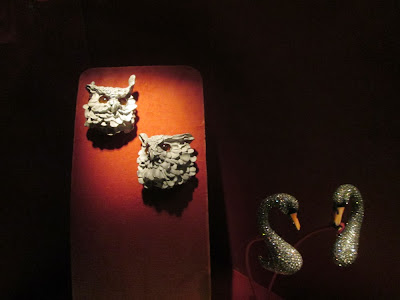Thursday, November 28, 2013
Happy Thanksgiving
Okay I couldn’t find a bejeweled Turkey so you’ll just have to make do with this $100 million diamond peacock brooch from Graff Diamonds.
In myth and legend the peacock has long carried portents of nobility, guidance and good luck. Turkeys just taste good.
Thanksgiving is the official start of the holiday season so my gift-giving guides will be up as soon as I can find the time to put them together. Travel begins again in a few days. I’ll be attending Art Basel Miami Beach and Design Miami. It’s my first time attending these events so it will be like a treasure hunt to me. The rest of my time will be dedicated to the holidays.
Enjoy
Please join me on the Jewelry News Network Facebook Page, on Twitter @JewelryNewsNet and on the Forbes website.
Wednesday, November 27, 2013
30% Increase in Customers at Treasures Hangzhou Jewelry Fair
The second edition of Treasures Hangzhou ended with a 30 percent increase in visitors, according to UBM Asia, who owns and operates the high-end jewelry show for consumers.
More than 1,200 high-net-worth consumers attended the three-day event at the Hyatt Regency Hangzhou, in eastern China near Shanghai.
“The increase in attendance numbers is certainly encouraging because it not only confirmed the strength of the high-end jewelry market in Eastern China, but also the healthy development of the Hangzhou Fair,” commented Joe Ho, UBM Asia’s Deputy Jewellery Fairs Manager for China.
Treasures Hangzhou is jointly organized by UBM China Holdings Limited, UBM China (Guangzhou) Co Ltd, the Jewelry Jade Industry Association of Zhejiang and Beijing San Arts Import & Export Co Ltd.
The fair provides a platform where consumers can purchase jewelry and gemstones from suppliers from various parts of the world. It featured about 30 high-end jewelry exhibitors from five countries and regions, namely: China, Hong Kong region, Sri Lanka, Taiwan region and Thailand. The exhibitors brought with them jewelry, diamonds, gemstones, pearls and jadeite jewelry.
During the fair, professional seminars were to held on jadeite and high-end jewelry, which including jewelry investment opportunities.
Please join me on the Jewelry News Network Facebook Page, on Twitter @JewelryNewsNet and on the Forbes website.
Monday, November 25, 2013
Benefit for Nicole Porto
I’ve known Nicole Porto for several years as the public relations representative for the Royal Asscher Diamond Company. She is a sweet person who does her job extremely well and who is far too young to have such a serious illness.
In June Nicole was diagnosed with aplastic anemia, a rare blood disorder. Since the illness was discovered she has undergone several blood transfusions and is scheduled for a bone-marrow transplant on December 6.
To help offset her medical expenses several of her many friends have set up the Nicole Porto Fund website where those who are interested can give a donation through PayPal.
In addition, friends of Nicole will hold a benefit on December 4 in New York at The Malt House on Thompson Street. It will include a jewelry sale, raffle and silent auction. The event admission is $25 that can be made at the website on in person at the event.
All of the proceeds from registration fees, silent auction and raffle tickets will go directly to Nicole's medical bills. Lita Asscher, Diana Widman and Lois Sasson are donating 35 percent of all jewelry sales to Nicole.
The raffle and silent auction prizes will include:
* Two free passes for flights anywhere in the U.S. on Virgin America Airlines!!
* Forty percent discount flight passes from Virgin America
* A 3-month membership to Equinox
* Dinner cooked by a professional chef
* Limited edition fine pens by Faber-Castell
* Nicole's favorite Diana Widman earrings
* A floating diamond necklace by Royal Asscher
* Fine jewelry donations by industry talent
* A summer weekend in a Vermont country house
More information and instructions about making donations and attending the event are on the website.
Please join me on the Jewelry News Network Facebook Page, on Twitter @JewelryNewsNet and on the Forbes website.
Sunday, November 24, 2013
Christie’s To Offer 52-Carat Golconda Diamond
Christie’s New York will be offering a 52.58-carat D-color internally flawless diamond from the fabled Golconda mine, revered for producing diamonds of a type, color, and degree of transparency that is rarely duplicated. It has a high estimate of $12.5 million.
The octagonal diamond with “superior polish” is the top attraction among 500 lots being offered at the December 10 Magnificent Jewels sale at Christie’s Rockefeller Center headquarters.
The auction is expected to achieve in excess of $45 million and will include jewels by several private collections, including four pieces of diamond jewelry created by the Leviev diamond company. The top item among the four pieces is a cushion-cut D-color internally flawless diamond ring of 26.72 carats mounted in platinum, flanked on either side by a shield-shaped diamond. It has a high estimate of $6 million.
In addition, there’s a diamond pendant necklace with a suspended 22.12-carat pear-shaped d-color, VVS1 diamond. The necklace has a high estimate of $3.5 million.
Please join me on the Jewelry News Network Facebook Page, on Twitter @JewelryNewsNet and on the Forbes website.
Old is New Again as F.P. Journe Recreates Groundbreaking Tourbillon Watch
 |
| F.P. Journe Historical Anniversary Tourbillon. |
François-Paul Journe was in Manhattan recently as part of a world tour celebrating his 30 years as the founder and head watchmaker of F.P. Journe. He also was in the city to introduce the Historical Anniversary Tourbillon, a recreation of the watch that began his career as an independent watchmaker.
 |
| The tourbillon movement |
Journe was barely in his 20s when he set about making a complex watch entirely by hand. It took him five years to create the tourbillon pocket watch, which launched F.P. Journe. Thirty years later the independent watch company based in Geneva, Switzerland, is now an international brand with nine boutiques around the world, including Manhattan, where Journe made his appearance.
| The original pocket watch created by François-Paul Journe 30 years ago. |
The anniversary wristwatch, limited to 99 pieces, is a reinterpretation of the original pocket watch, using some of the same materials, such as a guilloche silver case enhanced by two gold bezels in rose gold 4N.
The transparent sapphire back reveals the tourbillon movement of classic construction made in grained and gilded brass, identical to the original of 1983. Two parallel barrels distribute energy to a wheels train, arranged in the axis of the watch, which runs the tourbillon revolving in a minute. The lateral pallet escapement, which is more compatible with a wristwatch, replaces the detent escapement of the original, and the winding and time setting with a key have now been replaced by the 3 o’clock crown.
Made today in the company’s Geneva workshops, the movement features high quality components with modern polishing, beveling and finishing techniques that weren’t available 30 years ago. It encompasses a sobriety and a nobility of first generation tourbillon movements.
The movement is protected by a silver guilloche case back cover. The dial in grained silver is engraved with filled roman numerals and a steel hour circle, identical to the original tourbillon of 1983. The hours are indicated by blued steel Abraham-Louis Breguet hands, identical to those of the original pocket watch.
Please join me on the Jewelry News Network Facebook Page, on Twitter @JewelryNewsNet and on the Forbes website.
Saturday, November 23, 2013
A Look Inside the ‘Jewels By JAR’ Met Museum Exhibition
 |
| The darkened JAR exhibition space. Photo credit: Anthony DeMarco |
While stumbling in the dark bumping into other journalists (not literally but close) during the press preview of the “Jewels by JAR” exhibit at the Metropolitan Museum of Art, a common theme emerged. It changed how they view jewelry. The room was dark, the jewelry (art works really) glowed in the orange and red display cases and dazzled nearly all who saw them.
 |
| Orange Peel Brooch, 2001; Garnets, diamonds, enamel, silver, gold; private collection. Photo credit: Anthony DeMarco |
One prominent jewelry writer told me she doesn’t think she can ever wear jewelry again after seeing the 400 pieces on display. My lovely wife, who gets to view a lot of jewelry because of my work, no longer bothers to look at pieces that she now views as inferior.
That’s the thing about viewing jewelry (or anything) that is truly unique as those created by Joel A. Rosenthal, who of course is the man behind JAR. It increases your knowledge of a subject. It increases the possibilities of what can be done with a strong philosophy and dedication to that core value. It changes how you view everything. It can even redefine the things you value.
 |
| Rose Brooch, 2013; rubies, sapphires, spinels, diamonds, silver, gold; private Collection. Photo credit: Anthony DeMarco |
Not everyone got it. One person whom I know well came up to me in the dark and said she didn’t understand why the room had to be darkened. She didn’t get the jewelry. She didn’t understand how someone with absolutely no pedigree in the luxury jewelry world can suddenly move to Paris, set up shop at Place Vendôme, perhaps the world’s most famous shopping district, and gain such a reputation among the world’s wealthiest and most demanding jewelry buyers.
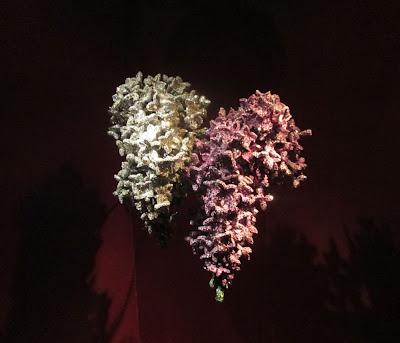 |
| Lilac Brooches, 2001–2; diamonds, garnets, sapphires, aluminum, silver, gold; private collection. Photo credit: Anthony DeMarco |
These are all fair questions that I’ve wondered about. It is unlikely we will ever get an answer. Rosenthal rarely gives interviews. He agreed to give a select few interviews for the exhibition, which opened Wednesday, including one with Vanessa Friedman of the Financial Times. She observed that Rosenthal pretty much does “what he wants, when he wants, for who he wants,” makes others in the creative professions envious. However, she added, “It is hard to know the kind of sacrifices it really demands.”
 |
| Snowflake Brooch, 2002; diamonds, platinum, silver, gold; private collection. Photo credit: Anthony DeMarco |
There was something that Rosenthal said in that interview that struck me.“I don’t care what the world thinks of me. But do I care, very deeply, what the people I care about think.”
This to me is an expression of the sacrifices he has made, his loyalty to those who has helped him achieve his vision, and how he feels about those who told him his concept of jewelry design as art would never work.
 |
| Five-Row Diamond Necklace with Pendant Ring, 1999; diamonds, platinum; private collection. Photo credit: Anthony DeMarco |
In the darkness of the room with the glow of lights from the displays, I had no idea how my photographs would come out. I'm happily surprised.
The retrospective of Rosenthal's 35-year career as the head of JAR will run till March 9, 2014.
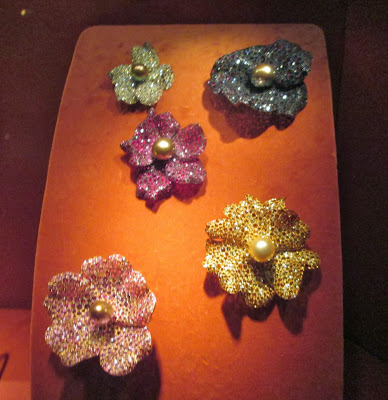 |
| Five Wild Rose Brooches, 1991; Oriental pearls, rubies, sapphires, amethysts, garnets, citrines, diamonds, platinum, silver, gold; private collection. Photo credit: Anthony DeMarco |
Please join me on the Jewelry News Network Facebook Page, on Twitter @JewelryNewsNet and on the Forbes Website.
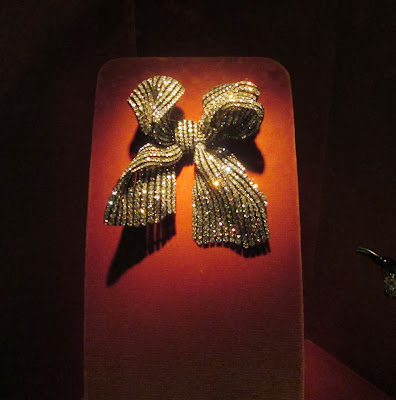 |
| Bow Knot Brooch, 2012; diamonds, silver, gold; private collection. Photo credit: Anthony DeMarco |
 |
| Ribbons Bracelet, 1990; diamonds, rubies, emeralds, sapphires, silver, gold; private collection. Photo credit: Anthony DeMarco |
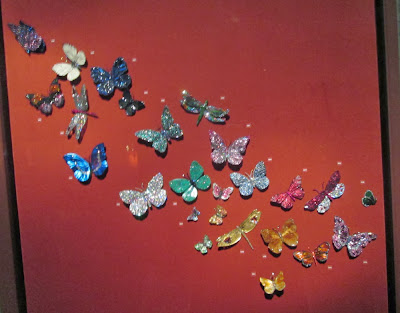 |
| Wall of butterflies. Photo credit: Anthony DeMarco |
 |
| Pendant Earrings, 2012; zircons, diamonds, platinum; private collection. Photo credit: Anthony DeMarco |
 |
| Drop Pendant Earrings, 2012; diamonds, platinum, silver; private collection. Photo credit: Anthony DeMarco |
 |
| Sheep's Head Brooch, 1997; sapphires, aluminum, gold; Suzanne Syz. Photo credit: Anthony DeMarco |
 |
| Lily of the Valley Brooch, 1991; Oriental pearl, diamonds, platinum, gold; private collection. Photo credit: Anthony DeMarco |
 |
| Oak Leaf and Acorn Earrings, 1990; Wood, gold; Susan K Gutfreund. Photo credit: Anthony DeMarco |
 |
| Necklace, 2005; diamonds, ribbon, silver, gold; private collection. Photo credit: Anthony DeMarco |
 |
| Pendant Earrings, 2013; chalcedony, diamonds, platinum, gold; Private collection. This is one of JAR's latest creations. Photo credit: Anthony DeMarco |
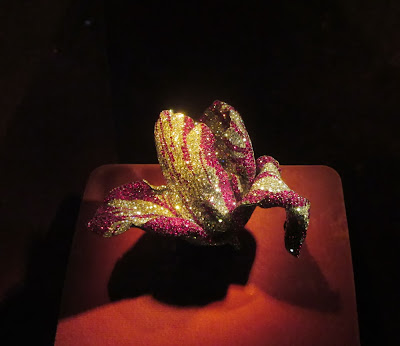 |
| Tulip Brooch, 2008; rubies, diamonds, sapphires, garnets, silver, gold, enamel; private collection. Photo credit: Anthony DeMarco |
 |
| Handkerchief Earrings, 2005; diamonds, silver, gold; private collection. Photo credit: Anthony DeMarco |
Tuesday, November 19, 2013
You Can Buy JAR Jewelry at Metropolitan Museum Exhibition
As I previously promised, I have the photographs of jewelry by Joel A. Rosenthal, better known to jewelry lovers across the globe as JAR, that he created specifically for the exhibition, Jewels By JAR, which opens Wednesday at the Metropolitan Museum of Art and runs till March 9, 2014. They are available for purchase exclusively at the museum.
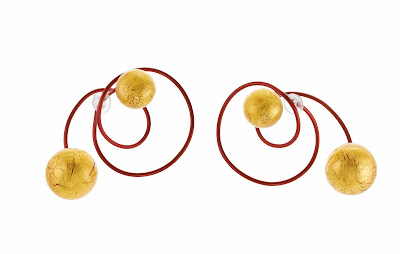 |
| Carnaval à Venise red titanium earrings with gold Venetian glass, $2,000. |
The pieces include earrings made of resin, 18k gold over aluminum, titanium and Venetian glass ranging in price from $2,000 to $7,500. There are also two watches designed for the event that cost $600. These creations will be available exclusively at the Museum through the close of the exhibition. These are not limited edition pieces but they are numbered.
 |
| Tickle Me Feather clip earrings, 18k over aluminum, $7,500. |
The exhibition will be the first retrospective in the United States of JAR’s work and the first retrospective at the Metropolitan Museum devoted to a contemporary artist of gemstone jewelry. It is only the second time his pieces were available to be seen at an exhibition, with the first being in London in 2002.
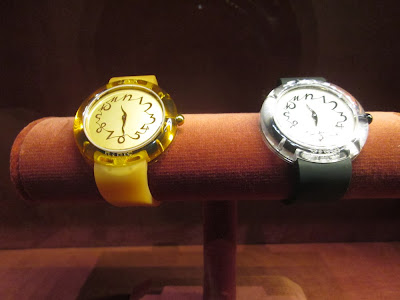 |
| JAR watches in two styles, $600 each. Photo credit: Anthony DeMarco |
Born in New York and educated at Harvard, Rosenthal moved to Paris soon after graduation and began to experiment with jewelry making. He opened JAR in 1978 on the Place Vendôme, in the same space he occupies today.
 |
| Carnaval à Venise black titanium earrings with gold Venetian glass, $2,000. |
“JAR jewels became known for their unique design, the exquisite quality of the gemstones, and their remarkable craftsmanship—but above all for their fearless beauty,” the museum said in a statement. “Rosenthal’s one-of-a-kind creations place him among the ranks of history’s greatest jewelers.”
 |
| Tickle Me Feather violet clip earrings made of resin and 18k gold, $4,000. |
The exhibition is described by the museum as a retrospective of his work for the 35 years he’s been designing jewelry under the JAR name. The exhibition of 400 works, mostly from private collections, presents a rare glimpse into the work of JAR and the museum store provides a rare opportunity to buy one of his pieces.
Please join me on the Jewelry News Network Facebook Page, on Twitter @JewelryNewsNet and on the Forbes Website.
Jewels By Jar, a Dazzling Display of Darkness and Light
 |
| Butterfly Brooch, 1994; Sapphires, fire opals, rubies, amethyst, garnets, diamonds, silver and gold; Private collection. Photograph by Katharina Faerber. Courtesy of JAR, Paris |
Jewelry is supposed to sparkle, glitter and glow. Joel A. Rosenthal, better known as JAR, also says it should “flicker,” which is why in his last exhibition, held in 2002 at the Somerset House in London, he requested that his jewelry be seen in the dark aided only by tiny flashlights.
Those visiting the Metropolitan Museum of Art for the landmark U.S. exhibition of Jewels By Jar won’t be asked to do anything drastic this time. However, in a museum bathed in light, the space dedicated to JAR is in darkness, with the exception of the spotted glow of jewelry displays.The designer who creates gemstone jewelry on the highest level is known for his fearlessness in his vision and in using a variety of jewelry techniques to create one-of-a-kind pieces for his private clients.
The exhibition, which opens Wednesday and runs till March 9, 2014, is the first US viewing of jewelry by the famed and famously reclusive jewelry artist. The exhibition will be the first retrospective in the United States of his work and the first retrospective at the Metropolitan Museum devoted to a contemporary artist of gems.
 |
| Raspberry Brooch, 2011; Rubies, diamonds, bronze, silver, gold, and platinum. Collection of Sien M. Chew. Photograph by Jozsef Tari. Courtesy of JAR, Paris. |
The press preview Monday at the museum was my first opportunity to see JAR jewelry pieces in the flesh and it didn’t disappoint. The 400 pieces on display, nearly all lent by private collectors, represent 35 years of designing jewelry at the highest level.
 |
| Lilac Brooches, 2001; Diamonds, lilac sapphires, garnets, aluminum, silver, and gold; Private collection. Photograph by Jozsef Tari. Courtesy of JAR, Paris. |
It’s obvious that Rosenthal isn’t a just a jewelry designer but an artist. In brief words during the press preview Monday, Jane Adlin, the exhibition curator, was a bit more specific, describing him as a sculptor.
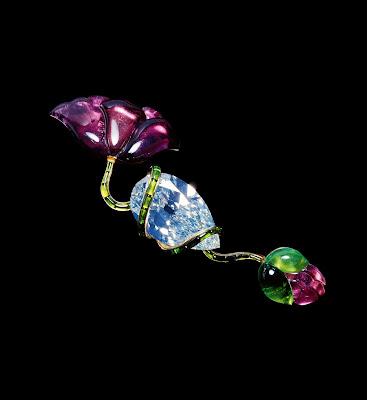 |
| Poppy Brooch, 1982; Diamond, tourmalines, and gold; Private collection. Photograph by Katharina Faerber. Courtesy of JAR, Paris |
“I think Joel is best known for his technique of pavé. He’s discriminating but indiscriminate in his use of gemstones,” Adlin said. “So he’ll mix very, very fine perfectly cut, perfectly flawless gemstones with some that are not. He will use lesser quality stones. He will use lesser-known stones. But the outcome is this extraordinary piece of jewelry, which if you just put it on your dresser or your coffee table it would in fact be a piece of sculpture.”
 |
| Bracelet, 2010; Diamonds, silver, and platinum; Private collection. Photograph by Jozsef Tari. Courtesy of JAR, Paris |
That’s probably the best way to look at the works of JAR. From the time of the Greeks, great sculptors are able to take a subject and create a more perfect vision of it. That’s part of Rosenthal’s skill and expertise. For example, his flowers and animals, in addition to being precise, seem to be more perfect than what nature intended. He can create texture with jewels, such as his colorful handkerchief earrings in which one has a fold. And, as previously mentioned, there’s his exemplary use of pavé combined with exceptional colors from the many types of gems he’ll use for a single piece. He treats metals the same way in his pieces as it ranges from gold, platinum and titanium to silver and aluminum.
 |
| Earrings, 2011; Emeralds, oriental pearls, diamonds, and platinum; Private collection. Photograph by Jozsef Tari. Courtesy of JAR, Paris. |
His 1994 butterfly brooch (one of many he created over the years) may be the best example of all of his sculptural attributes. Like many of his pieces it’s a combination of multiple materials. In this case sapphires, fire opals, rubies, amethyst, garnets, diamonds, silver and gold. Colors include different shades of violet, red, orange, yellow, blue and green with specks of white. Micro pavé is used throughout. In some cases there’s clear separation of color, in other parts of the creature, the colors seem to blend together.
 |
| Zebra Brooch, 1987; Agate, diamonds, a sapphire, silver, and gold; Private collection. Photograph by Katharina Faerber. Courtesy of JAR, Paris. |
The mystique of JAR is enhanced by the man himself. Rosenthal is famously private. The New York native who lives and works in Paris has rarely given interviews although he did agree to a select few for this exhibition. The window of his store on Place Vendôme, perhaps the most famous luxury shopping district in the world, is often blank or showing a single object unrelated to jewelry design, such as a twig. The customers who are fortunate enough to enter his chambers get singular treatment and leave, eventually, with unique pieces of art created just for them.
 |
| Tulip Brooch, 2008; Rubies, diamonds, pink sapphires, garnets, silver, gold, and enamel; Private collection; Photograph by Jozsef Tari. Courtesy of JAR, Paris. |
His eccentricity was apparently on display during the preparation of the Met exhibit. To the disappointment of many Rosenthal wasn’t present at the press preview with staff saying he is “shy.”
But we did get a bit more detail of the man behind JAR from Jennifer Russell, Metropolitan Museum associate director for exhibitions.
“Joel is passionate, he’s opinionated, he has a very definite point of view about almost everything, from what he’s going to eat for lunch to how the show should be arranged,” she said. “But he listens too and it’s been a wonderful dialogue in deciding how things should be arranged and discussing the exhibition in general.”
Please join me on the Jewelry News Network Facebook Page, on Twitter @JewelryNewsNet and on the Forbes Website.
Thursday, November 14, 2013
5% Increase in Q3 Gold Jewelry Demand
Gold jewelry demand for the third quarter of 2013 increased 5 percent year-over-year to 486.7 tons, the World Gold Council said Thursday, marking the best third quarter performance for the precious metal since 2010.
In terms of value, gold being used for jewelry for the period fell by 15 percent year-over-year, due to a drop in the trading price of the precious metal, according to the WGC’s Gold Demand Trends report for the third quarter of 2013. Demand for the period was worth $20.8 billion, the lowest quarterly value since the third quarter of 2010.
Global growth for the period was led by high-karat gold jewelry purchases in Asia, the Middle East and the US,
“An almost universal phenomenon in the third quarter was the increasing popularity of higher carat jewelry,” the WGC said in its report. “Across Asia, the Middle East and in the US, higher carat jewelry was noted as an area of particular growth as the increased investment properties associated with gold of higher purity came to the fore. The fact that jewelry retailers in a number of markets were increasingly stocking investment products (small bars and coins) provided further evidence of the greater blurring of the jewelry/investment distinction.”
Consumers in China generated 163.7 tons of jewelry demand in the third quarter, making it by far the largest single jewelry market. The country’s year-to-date, demand of 518 tons already equals the same amount for the full-year 2012.
“To some extent, exhaustion set in towards the end of Q3 after such a frenetic second quarter, but continued expansion of the retail network confirms that the trade sees prospects for growth,” the WGC said.
Increases were reported in 24k jewelry (known as “chuk kam”), which has a purity rating of 95.95 percent and in “four nines” gold (gold jewelry of 99.99% purity, compared with the typical 24-carat purity of 99.95%). The WGC explained that the former is unique to China and is most popular with consumers in lower tier markets and rural areas as an investment hedge.
Mainland Chinese consumers also attributed to a 28 percent increase in gold jewelry consumption in Hong Kong to 7.5 tons.
In the US, the WGC noted that “demand was a key development.” Gold jewelry demand for the third quarter rose 14 percent year-over-year to 43.4 million tons.
With the exception of fourth quarter demand (driven by holiday sales), the third quarter was the first quarter in four years in which gross jewelry demand exceeded recycling—creating net positive jewelry demand,” the WGC said. “Since Q3 2009, gross new quarterly jewelry demand had been exceeded by the recycling of old gold jewelry as distress selling took off during the economic downturn,” WGC said. “Increasingly positive sentiment among US consumers during the third quarter reversed this trend.”
The report also notes a shift towards 18k jewelry from 14k.
“Given recent developments in the US, consumer sentiment has taken a hit early in the fourth quarter, but the seasonal impact, together with prices holding below US$1,400/oz, suggests a certain amount of resilience,” the WGC said.
India, one of the world’s largest markets for gold jewelry, saw demand drop by 23 percent year-over-year to 104.7 tons due to import restrictions imposed by the government. “Demand for gold jewelry among Indian consumers remains strong, but reduced supply has prevented this demand from being fully realized,” the WGC said.
"The smaller Asian markets had robust growth for the period, with the exception of South Korea where weak consumer sentiment and a sluggish domestic economy dampened demand," the WGC said. "Across the rest of the region, there was a trend for higher karat jewelry pieces of relatively simple design as consumers across the region took advantage of gold’s increased affordability."
Gold jewelry demand in the Middle East increased 9 percent to 51.2 million tons, due to lower prices across the region, the WGC said. The “unsurprising” exception was Egypt.
“The emphasis on 22-karat gold at the expense of 21- and 18-carat diamond-set jewelry suggests demand was stronger among domestic consumers relative to western tourists.”
The third quarter in Turkey, which is traditionally strong, saw year-over-year demand increase 14 percent. In value terms, demand was virtually flat, due to a 12 percent decline in the local currency price of the precious metal.
Russia’s growing middle class, armed with greater disposable income, helped generate a 7 percent year-over-year growth in jewelry demand.
“European markets were again the exceptions to the more positive global picture, with both UK (-14%) and Italy (-7%) posting year-over-year declines due to “economic concerns,” WGC said.
Please join me on the Jewelry News Network Facebook Page, on Twitter @JewelryNewsNet and on the Forbes Website.
Wednesday, November 13, 2013
The Pink Star Diamond Fetches World Auction Record Of $83 Million
The 59.6-carat Pink Star diamond lived up to its hype by selling for a world record price of approximately $83.4 million at Sotheby’s Geneva Magnificent Jewels sale Wednesday.
When introducing the internally flawless fancy pink vivid diamond, David Bennett, chairman of Sotheby’s Jewellery Division in Europe and the Middle East, called it “one of the most remarkable gems to ever appear at auction.”
Bidding opened at 48 million Swiss francs and gradually climbed to 64 million Swiss francs. After a pause it quickly climbed to 67 million francs ($73.2 million), shattering its $60 million high estimate. Nervous laughter could be heard on Sotheby’s live feed as the bidding slowly pushed up to the winning bid 68 million Swiss francs. Commission fees pushed the final total to more than 76.3 million Swiss francs ($83.4 million).
The diamond is graded as Type IIa, which is rare for any pink diamond, much less one of this size and color. Cut over a period of two years, The Pink Star is more than twice the size of the Graff Pink—a 24.78-carat fancy intense pink diamond that established a world auction record for a diamond and any gemstone or jewel at $46.2 million, at Sotheby’s Geneva in 2010. The current record price per carat for a fancy vivid pink diamond of $2,155,332 is set by a 5-carat diamond, sold in Hong Kong in January 2009. The current record price for any colored diamond sold at auction is $2,398,151 per carat, for “the Orange,” a 14.82-carat fancy vivid orange diamond that sold a day earlier at Christie’s Geneva Magnificent Jewels auction. The per carat price for the The Pink Star has yet to be released and will be updated.
Cut by Steinmetz Diamonds over a period of nearly two years from a 132.5-carat rough, the diamond was first unveiled to the public in May 2003 as the “Steinmetz Pink.” The stone was first sold privately in 2007 and renamed The Pink Star.
Please join me on the Jewelry News Network Facebook Page, on Twitter @JewelryNewsNet and on the Forbes Website.
Subscribe to:
Posts (Atom)







